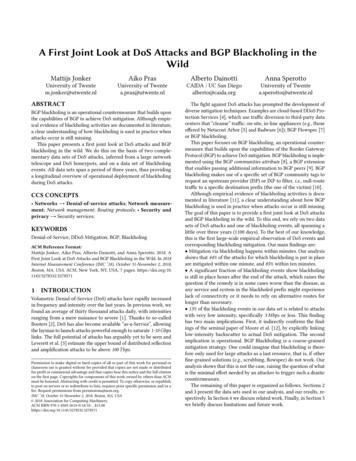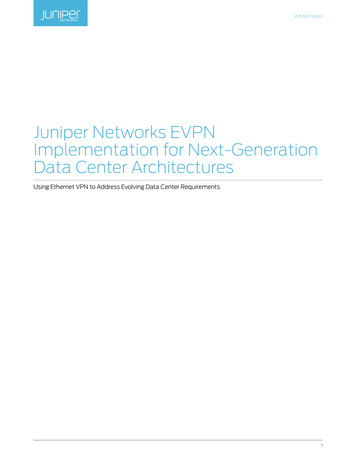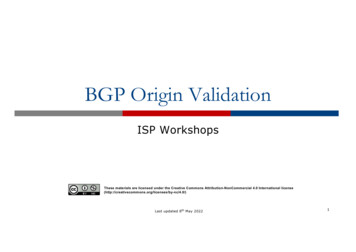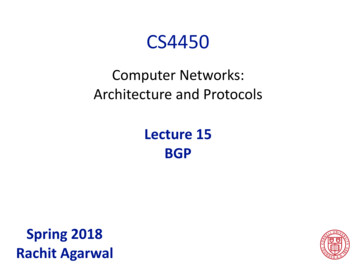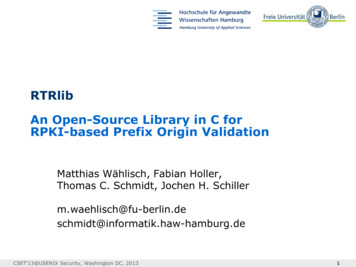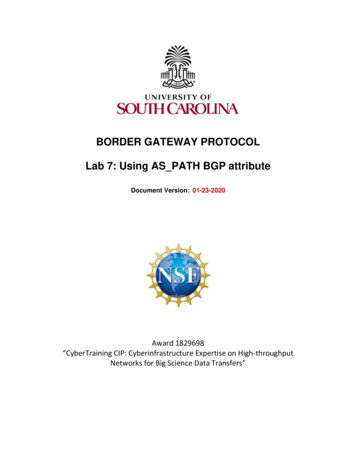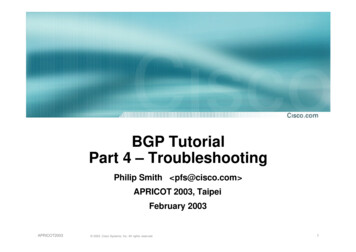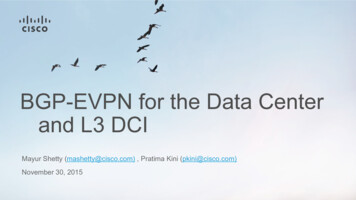
Transcription
BGP-EVPN for the Data Centerand L3 DCIMayur Shetty (mashetty@cisco.com) , Pratima Kini (pkini@cisco.com)November 30, 2015
Agenda What is EVPN ? What problems does VXLAN solve ? What problems does BGP EVPN solve ? Overview of BGP EVPN Route Types and associated use cases Host IP/MAC distribution IP Prefix route Layer-3 DCI L3 handoff between VXLAN-EVPN and MPLS-L3VPN to extend the layer-3 network connectivityacross Data Centers over a WAN2
What is E-VPN? Ethernet VPN (EVPN) – connect a group of customer sites using a virtual bridge. Treat MAC addresses as routable addresses and distribute them in BGP Uses Multi-protocol BGP Initially started as next generation L2VPN solution for service provider networks Evolution of EVPN Data center use cases Multi-tenancy with virtualized hosts Support of VXLAN and NVGRE encapsulations Integrated routing and bridging Support exchange of IP addresses and IP prefixes Status of EVPN Standardization effort - IETF L2VPN work group Multi-vendor support – core set of drafts co-authored by engineers from Cisco, Juniper, Alcatel-Lucent,Verizon, ATT, Bloomberg. BGP MPLS based EVPN is RFC 7432 and extensions for DC is currently in draft stages.3
WhyVXLAN?Whatproblemsdoes VXLAN –VLANslimitedbyL3boundariesAnyWorkloadanywhere- segmentsSecureMulC- TEPVTEPVTEPVTEP4
Challenges New Scale and Mobility LimitationsVXLAN OverlayVTEPVTEPVTEPVTEPVTEPLIMITED SCALEFlood and learn (BUM)- Inefficient Bandwidth UtilizationCENTRALIZEDCentralized Gateways, Controller – Traffic Hair-piningResource Intensive – Large MAC TablesSub-Optimal Traffic ployments5
What problems does BGP EVPN solve for VXLAN? Control plane for VXLAN overlays Optimize/eliminate flooding of Unknown unicast traffic. Protocol messages, e.g. ARP Virtual machine mobility with optimal forwarding No hair pinning of traffic to previous location Active/active multi-homing with per flow load balancing Large scale multi-tenancy in control plane with characteristics of L3VPN Route filtering and constrained route distribution Ingress replication of multi-destination traffic Multicast free underlay6
BGP-EVPN / VXLAN Terminology1. Layer-2 VNI VNI (VXLAN network identifier) carried in VXLAN packets bridged acrossVTEPs (VXLAN tunnel end point) . This VNI is configured per VLAN.2. Layer-3 VNI VNI carried in the VXLAN packets routed across VTEPs. This VNI is linked per Tenant VRF.3. Anycast GW All L3 VTEPs are configured with same mac and same subnet for host facing SVI.4. VRF overlay VLAN Every Tenant VRF will need a Vlan to be configured for VXLAN routing. This VLAN is configured with L3-VNI.5. VXLAN L2 Gateway VTEP capable of switching VLAN- VXLAN, VXLAN- VLAN packets with in same VNI.6. VXLAN L3 Gateway VTEP capable of routing packets across different VNIs.7
EVPN ControlPlane– ReachabilityDistributionMP-BGPfor VXLANEVPNControl PlaneEVPN Control Plane -- Host and Subnet Route DistributioniBGP AdjacenciesRRVTEPBGP Update Host-MACHost-IPInternal IP SubnetExternal PrefixesVTEPSpineRRVTEPVTEPRRRoute-Reflectors deployedfor scaling purposesLeaf§ Use MP-BGP with EVPN Address Family on leaf nodes to distribute internalhost MAC/IP addresses, subnet routes and external reachability information§ MP-BGP also used to distribute IP multicast groups information§ MP-BGP enhancements to carry up to 100s of thousands of routeswith reduce convergence time348
BGP EVPN Route TypesRoute-TypeEVPN RoutesPurpose1Ethernet Auto-discovery RouteMass withdrawal and Aliasing2MAC/IP RouteAdvertise host MAC and IP address3Inclusive Multicast RouteTunnel end point discovery for setting up of replicationlist4Ethernet Segment RouteDiscovery of nodes in redundancy group and DF-election5IP Prefix routeAdvertise IP prefixes9
BGP EVPN MAC Route (Type – 2 Route) RD:per VPN RDMAC Len:48MAC Addr:Host-MACIP Length:32IP address:Host-IPLabel1: VNI for BDLabel2: VNI for VRFRoute Target RT for EVI RT for VRFTunnel Attribute Tunnel Type MAC:VXLANRouter MACMAC Mobility Sequence Number10
BGP EVPN Control Plane for VXLANL2 Overlay (Type-2 Route)BGP–EVPNMAC H1:VNI1MAC H2:VNI2BGP–EVPNMAC H3:VNI1MAC TOR1Vlan1Vlan2(VNI1)(VNI2)MAC H1MAC H2VXLANTunnelTOR2Vlan1Vlan2(VNI1)(VNI2)MAC H3MAC H4Advertisement of MAC:VNI bindings from a TOR via BGP EVPN enablesa remote TOR to send bridged traffic to that MAC using the VNI for that MAC tothe TOR that advertised the MAC over VXLAN11
BGP EVPN Control Plane for VXLANL3 Overlay (Type-2 Route)BGP–EVPNIP H1:VNI3IP H2:VNI3BGP–EVPNIP H3:VNI3IP 1VRF1VXLANTunnelVNI3VNI3IP H1TOR2VRF1IP H2IP H3IP H4Advertisement of IP:VNI bindings from a TOR via BGP EVPN enables a remote TOR to sendrouted traffic to that IP using the VNI for that IP to the TOR that advertised the IP over VXLAN12
BGP EVPN IP Prefix Route (Type – 5 Route)RD: VRF RDEthernet Segment: 0Ethernet Tag: 0IP Address Len: 0-32IP Address: IP prefixGW IP Address: 0Label : L3 VNIRoute Target RT for VRF Tunnel Attribute Tunnel Type MAC:VXLANRouter MAC13
BGP EVPN Control Plane Type-5 RouteIP Prefix Route:Prefix : 10.1.1.0/24VNI : L3 VNINext Hop : IP-L1Router MAC : System MAC of NISubnet10.1.1.1/2414
DCI OverviewDC1 L3 DCI Service: EVPN-VXLAN to IP VPN (unicast) Interworking on DCI L2 DCI Service: EVPN-VXLAN to VPLS Interworking on DCI EVPN-VXLAN to OTV Interworking on DCI EVPN-VXLAN to EVPN-MPLS Interworking on afEVPN-VXLANDCIDCIDC2OTV or EVPN w seamless VPLSinterworking15
L3 DCI ServiceEVPN Label VRF-VNIDRTNH VTEP- ‐IPTunnelENCAP VXLANExtCommAdr:RMACIPVPNeBGP VNID: per-VRF encap, downstream assigned by BL and DCIMAC: next-hop router MAC (BL, DCI)NH: VTEP IP (BL, DCI)RT: coordinated between each DCI-BL pairENCAP: VXLAN16
L3 DCI Service – Control PlanePrefix 1.1.1.0/24MAC: bleaf-MACVRF-VNI: 101NH: VTEP-BLRT: ASN:XENCAP: VXLANPrefix 1.1.1.0/24MPLS label: 16001DC1DCI/WANPE/ASBRSpineWANPE/ASBRHost A:1.1.1.1LeafLeafbLeafbLeaf Fabric can advertise aggregated prefix andspecific host route to WANWAN router will typically advertise defaultroute into fabricHost E:5.5.5.5PE/ASBRPrefix 5.5.5.0/24MPLS label: 26001Prefix 5.5.5.0/24MPLS label: 56001 ClientPE/ASBRPrefix 0.0.0.0/0MAC: DCI-MACVRF-VNI: 102NH: VTEP-DCIRT: ASN:XENCAP: VXLAN per-VRF VNI assignmentVNI is local router significant and assigned by downstream router justlike MPLS VPN labelIngress and egress VNIs can be different for same VRFRT is unique per-VRF between fabric and WAN as the “glue”MAC is next-hop router MAC which could advertised global per-VTEPor per-VNI / VRFNH is set to VTEP IPENCAP is set to VXLAN17
L3 DCI Service – DCI Forwarding Plane1. WAN - FabricMPLSPacketLabellookupper-VRFLabel - VRFVRF FIBlookupVXLAN ENCAP(VRF-VNI)VXLANPacketper-prefix2. Fabric - WANVXLANPacketVNIlookupVNI - VRFVRF FIBlookupL3VPN MPLSENCAPMPLSPacket18
References VXLAN: A framework for overlaying Virtualized Layer 2 Networks over Layer 3 Networks --RFC 7348Ø https://tools.ietf.org/html/rfc7348 BGP MPLS based EVPN -- RFC 7432Ø https://tools.ietf.org/html/rfc7432 Requirements for Ethernet VPN (EVPN)Ø https://tools.ietf.org/html/rfc7209 A Network Virtualization Overlay Solution using EVPNØ verlay-0218
Use MP-BGP with EVPN Address Family on leaf nodes to distribute internal host MAC/IP addresses, subnet routes and external reachability information ! MP-BGP also used to distribute IP multicast groups information ! MP-BGP enhancements to carry up to 100s of thousands of routes with reduce convergence time


